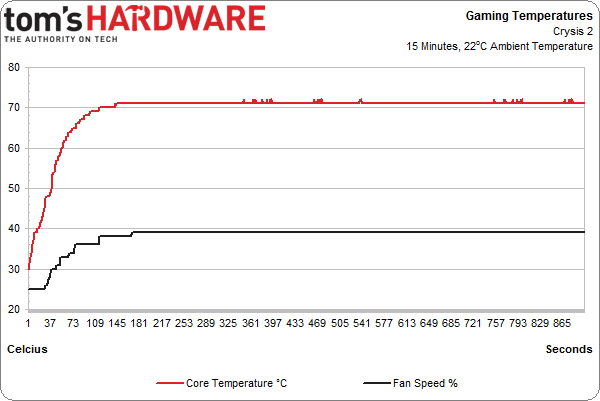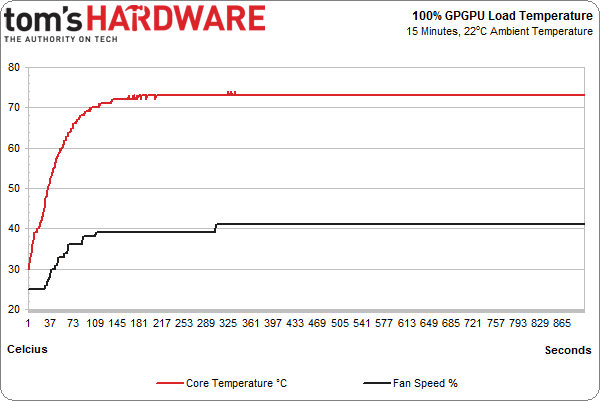Tahiti LE, Tested: PowerColor's HD7870 PCS+ Myst Edition
Today, we look at a card between two worlds. Despite a model number that suggests Pitcairn lineage, this board is based on AMD's Tahiti GPU. Does it behave more like its namesake, or the powerful engine actually under its hood? Read on for more!
Power, Noise, And Heat
Power Consumption and Noise
The PowerColor HD7870 PCS+ Myst Edition consumes a lot more power than the Pitcairn-based Radeon HD 7870. Occasionally, it even demonstrates higher power consumption than the Radeon HD 7950, though this is probably a result of its higher GPU voltage. If it seems like you've seen this play out before, think back to ATI's Radeon HD 5830.
Ah well. The table below has the most important power consumption-related numbers, along with noise levels that correspond to each workload.
| Load | Noise Level | Power Consumption |
|---|---|---|
| Idle | 31.4 dB(A) | 12 W(Radeon HD 7870 app. 12 W, Radeon HD 7950 app. 11 W) |
| Blu-ray Playback | 32.8 dB(A) | 68 W(Radeon HD 7870 app. 45 W, Radeon HD 7950 app. 54 W) |
| Gaming | 37.8 dB(A) | 175 W(Radeon HD 7870 app. 115 W, Radeon HD 7950 app. 145 W) |
| Stress Test / GPGPU | 40.3 dB(A) | 200 W(Radeon HD 7870 app. 148 W, Radeon HD 7950 app. 180 W) |
The temperature and fan speed curves fit with these numbers. PowerColor is pretty conservative with the HD7870 PCS+ Myst Edition’s fan control. It starts at only 25% duty cycle and revs up slowly as the temperature increases. Pushing the card hard does result in quite a bit of noise, but it remains bearable. Seemingly, PowerColor allowed higher temperatures to help keep acoustic output in check.
We achieved the temperatures in the chart above using an open test bed, but the card exceeds 75 degrees Celsius in a closed case (Corsair Obsidian 800D). This is just barely on the right side of acceptable, but certainly not a great result.
Get Tom's Hardware's best news and in-depth reviews, straight to your inbox.
Current page: Power, Noise, And Heat
Prev Page Boost, Overclocking, And CrossFire Next Page Tahiti LE: A High-Powered Value Play
Igor Wallossek wrote a wide variety of hardware articles for Tom's Hardware, with a strong focus on technical analysis and in-depth reviews. His contributions have spanned a broad spectrum of PC components, including GPUs, CPUs, workstations, and PC builds. His insightful articles provide readers with detailed knowledge to make informed decisions in the ever-evolving tech landscape
-
mayankleoboy1 Isnt this review quite a bit late ? IIRC, the card came ~1.5 months back...Reply
If it cant CFX with a 78xx, it has no right to be called a 7870+ . Marketing name fail +1.
The chip by itself is fine, though.
-
EzioAs That's quite a short review. It's not anything I haven't looked at other sites. Anyway, at the current price, I really have to agree the 7870XT (Tahiti LE) are excellent cards.Reply -
EzioAs Reply10449154 said:If it cant CFX with a 78xx, it has no right to be called a 7870+ . Marketing name fail +1.
I agree. AMD has already establish good model naming scheme (X900 for high-end gaming, X800 for mid-range, X700 for low end gaming) after the 6000 series. To be honest, I say it's stupid not to call this chip the HD7930. -
hero1 Azn CrackerOr maybe the 7950 LE since its pretty much the same card just slower.Reply
I agree with you on this one. Someone need to give these guys a call and tell them how it is. What a load of bs on their naming scheme. I would absolutely call this 7950 SS or LE! -
FormatC The frametime thing (in some games) was gone (more or less) with the latest drivers and I think that AMD will handle the memory now a little bit better ;)Reply -
shikamaru31789 If only some other manufacturers were making these, Power Color's cooling solution isn't that good, 37.8 decibels while Gaming is not quiet enough for me.Reply -
EzioAs Reply10449161 said:If only some other manufacturers were making these, Power Color's cooling solution isn't that good, 37.8 decibels while Gaming is not quiet enough for me.
Sapphire has one too, I believe -
shikamaru31789 EzioAsSapphire has one too, I believeYeah, I just now noticed it on Newegg. Not sure why I didn't notice it before, based on the reviews it's been on there awhile. Too bad it costs $20 more than Power Color's. Still a good deal even at $260, since this review indicates that it's almost as fast as the much more expensive 7950's.Reply

